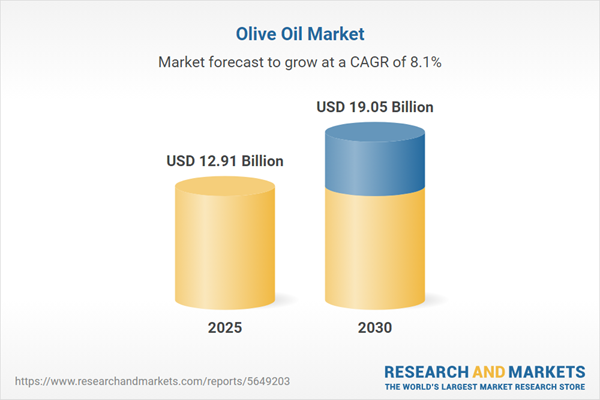Olive oil is extracted from the olive fruit and is generally manufactured by physical or mechanical processes using grind, press, centrifuge, filtration, and various other methods. It can also be prepared chemically by using chemical solvents. However, using the olive oils produced by mechanical techniques under supervised conditions is often recommended. Olive oil is used in various industry verticals, such as food, cosmetics, and pharmaceuticals worldwide.
Olive oil has traditionally been an inevitable part of European and Mediterranean cuisine, gaining prominence globally. It has numerous benefits, such as treating cardiovascular diseases, cancer, diabetes, etc. The European government has often promoted olive oil by celebrating World Olive Day on 26th November and other marketing campaigns and trade associations such as the Spanish Olive Interprofessional.
The market has been segmented based on the type into virgin oil, refined oil, standard oil, and crude oil; by production into mechanical and chemical. Based on distribution into business-to-business (B2B) and retail Individuals.
The nations abundant with olive as a natural resource, mainly beside the Mediterranean basin, are the largest producers of olive oil and its variants. However, other areas such as California, Argentina, Chile, Peru, South Africa, and Australia have favorable climates for olives and are recognized as olive oil producers.
According to the World Integrated Trade Solution (WITS), the top importers of olive oil and fractions in 2023 were the United States with 90,988,200 Kg imports, then Italy, followed by Spain with 34,832,100 Kg, the United Kingdom, and Portugal with 21,746,200 Kg of imports.
Secondly, the top importers of Virgin olive oil and fractions were Italy, the United States, Spain, the European Union, and France in 2023.
According to the Italian Institute for Agri-Food Statistics (ISMEA), the International Olive Oil Council (IOC), and the European Commission, the world olive oil production for the 2024/25 season could increase by 23% and by some 588,000 tonnes compared to the previous season, which stood at 2.51 million.
Olive oil market drivers:
Innovative and higher-quality olive oil product offerings
The demand for olive oil is increasing at a constant rate within European and non-European countries. The manufacturers' rising demand calls for innovative product offerings, which are now serving olive oil with natural flavorings and added extracts such as garlic, chili, basil, truffle, and many others. The London International Olive Oil competition for the best-flavored olive oil category and high product quality supported the move.Olive oil market geographical outlook
By geography, the olive oil market is segmented into North America, South America, Europe, the Middle East and Africa, and Asia-Pacific. The major economies like China, Japan, India, and South Korea dominate the Asia-Pacific region. Some of the fastest-growing emerging economies are from this region, such as ASEAN countries.The Asia-Pacific region is expected to see notable growth in the olive oil market. In 2023, India imported 1,693,890 Kg of virgin olive oil and fractions. This growth in olive oil is due to the expanding cosmetic industry, increased domestic consumption, and changing lifestyle scenarios.
North America is expected to have a significant market share for olive oil. The United States import of virgin olive oil and fractions has expanded from US$1.18 billion in 2021 to US$1.65 billion in 2023. This increased consumption is due to the known benefits of richness in healthy monounsaturated fats.
With the changing food preferences, the olive oil trade has emerged in countries outside the European Union. However, Europe continues to exhibit stable demand of around 3-5% every year. Moreover, Australia, China, Japan, and Canada have also experienced strong demand and growth in the consumption of olive oil.
Reasons for buying this report:
- Insightful Analysis: Gain detailed market insights covering major as well as emerging geographical regions, focusing on customer segments, government policies and socio-economic factors, consumer preferences, industry verticals, other sub-segments.
- Competitive Landscape: Understand the strategic maneuvers employed by key players globally to understand possible market penetration with the correct strategy.
- Market Drivers & Future Trends: Explore the dynamic factors and pivotal market trends and how they will shape up future market developments.
- Actionable Recommendations: Utilize the insights to exercise strategic decision to uncover new business streams and revenues in a dynamic environment.
- Caters to a Wide Audience: Beneficial and cost-effective for startups, research institutions, consultants, SMEs, and large enterprises.
What do businesses use our reports for?
Industry and Market Insights, Opportunity Assessment, Product Demand Forecasting, Market Entry Strategy, Geographical Expansion, Capital Investment Decisions, Regulatory Framework & Implications, New Product Development, Competitive IntelligenceReport Coverage:
- Historical data & forecasts from 2022 to 2030
- Growth Opportunities, Challenges, Supply Chain Outlook, Regulatory Framework, Customer Behaviour, and Trend Analysis
- Competitive Positioning, Strategies, and Market Share Analysis
- Revenue Growth and Forecast Assessment of segments and regions including countries
- Company Profiling (Strategies, Products, Financial Information, and Key Developments among others)
The Olive Oil Market is segmented and analyzed as below:
By Product Type
- Virgin Oil
- Refined Oil
- Pomace Oil
By Production
- Physical/ Mechanical
- Chemical
By Distribution
- Offline
- Supermarkets
- Hypermarkets
- Others
- Online
By Industry
- Retail Households
- Food and Beverage Industry
- HoReCa Industry (Hotels, Restaurants, and Catering)
- Others
By Geography
- North America
- South America
- Europe
- Middle East and Africa
- Asia-Pacific
Table of Contents
Companies Mentioned
- Avril Group
- Albert Heijn
- Deoleo
- Sovena
- Borges
- Minerva
- Gallo
- Urzante
- Mercaoleo
Table Information
| Report Attribute | Details |
|---|---|
| No. of Pages | 147 |
| Published | December 2024 |
| Forecast Period | 2025 - 2030 |
| Estimated Market Value ( USD | $ 12.91 Billion |
| Forecasted Market Value ( USD | $ 19.05 Billion |
| Compound Annual Growth Rate | 8.0% |
| Regions Covered | Global |
| No. of Companies Mentioned | 9 |









